A plant like Levkoy (Matthiola) is also called mattiola. It is related to the genus of herbaceous annuals and perennials of the cruciferous or cabbage family. In natural conditions, Levkoy can be found in Southern Europe, Africa and neighboring regions of Asia. This genus includes 20-50 species. Such a plant is decorative with fragrant flowers. R. Brown gave the Latin name to this flower in honor of the Italian P. Mattioli, a physician and botanist who lived in the 16th century. The name Levkoy comes from Italian, German or Latin. The point is that these languages have similar source words. From Greek "levkoy" is translated as "white violet". In the 20th century, such a plant could be found in almost any park and garden, but in the 21st century, for some reason, such a flower went out of fashion. If you are an adherent of the park style, then this flower is what you need.
Content
Features of Levkoy
Levkoy is a herbaceous plant or shrub, which can be perennial, biennial or annual. The height of erect branched shoots can vary from 0.2 to 0.8 meters, they are pubescent with a felt pile or glabrous. Lanceolate or oblong-shaped sheet plates can have a serrated or solid edge. The inflorescence is racemose or spike-shaped, consisting of double or simple flowers, which can be colored pink, purple, white and dirty yellow. Flowering is observed in June-November. The fruit is a pod, inside of which there are flat narrow-winged seeds. The aroma emanating from Levkoy flowers cannot be confused with any other. Varieties with simple flowers are considered excellent honey plants, while double ones are a wonderful decoration for any garden. Everyone can grow such a flower, even those people who are far from gardening.
Growing Levkoy from seeds
Sowing
Before you start sowing, you need to prepare the seeds. To do this, they are soaked in water for 24 hours, and then put in moistened gauze and put on the refrigerator shelf for several days for stratification. Sowing seeds for seedlings is carried out in the last days of March or the first days of April in boxes or containers, which must first be filled with a moistened soil mixture, which includes turf and sand (3: 1). Sowing should be done sparsely, while the seeds should be buried only half a centimeter.Then the container must be covered with a film or glass and moved to a warm (from 20 to 22 degrees) and dark place. In some cases, the first seedlings can be seen in just 4–5 days, but they can appear even after half a month.
Seedling
After the first seedlings appear, the shelter must be removed, and the container must be rearranged in a well-lit place with diffused light, this will not allow the plants to stretch out. The required temperature for growing seedlings is from 10 to 12 degrees, so it is recommended to transfer containers to an unheated veranda or a protected balcony. Two days after the first seedlings appear, they will need to be watered for the first time. After 10-12 days, the seedlings should be dived into individual pots with holes for drainage. They should be filled with a soil mixture consisting of sod and leafy soil and sand, which must be taken in a ratio of 2: 2: 1. It should be borne in mind that by this time the plants will not have a single true leaf plate. During the dive of seedlings, it is recommended to add a small amount of hydrogel to the substrate, which will strengthen the root system of the plants. Late, as well as mid-flowering varieties, if desired, can be dived directly into open soil. The first feeding should be done when the plants begin to develop a second true leaf blade. For feeding, microfertilizers should be used, for this, 0.3 grams of boric acid and copper sulfate and 0.1 grams of manganese sulfate and zinc sulfate are taken for 1 liter of water. The seedlings of such a plant must be hardened. To do this, first open the window on the balcony for a short time, while the procedure time is gradually increased. Finally, the flowers should be kept with the window fully open. Seedlings should be hardened 1–1.5 weeks before planting in open soil.
Planting Levkoy in open ground
What time to plant
Levkoy seedlings should be planted in the last days of May. To do this, you need to choose a cloudy day or make a landing in the evening, because the scorching sun rays can ruin the newly planted seedlings. The area where plants belonging to the cruciferous family previously grew is not suitable for planting matthiola, otherwise the cruciferous flea may destroy the flowers. It should also be noted that the soil from such a site is also not suitable for filling containers for growing seedlings of Levkoy, because there is a high probability that the plants will get sick with a black leg or keel.
When choosing a place for planting, it should be borne in mind that such plants need a lot of sunlight and well-drained soil, since if liquid stagnates in the soil, this can greatly harm the levkoy. The soil should be neutral or slightly alkaline, saturated with nutrients and it is better if it is sod-loamy or sod-sandy loam. Fertilize the soil before planting only when it is excessively depleted.
How to plant
First you need to prepare the holes, and then fill them with water. Planting must be done directly into the earthen slurry, this will allow the plants to quickly adapt to new conditions. When the holes are filled with soil, it must be properly compacted. The distance between low-growing and single-stemmed varieties should be about 15–20 centimeters, and between branched and tall ones - from 25 to 30 centimeters.
Levkoy care in the garden
The most important thing to remember when growing matthiola is that it reacts extremely negatively to both prolonged drought and too much watering. In this regard, watering should be moderate and always systematic.Also, while caring for such a plant, it is necessary to weed it in time and systematically loosen the soil surface on the site, and this should be done every time after the plant is watered. Of the organic matter, only wood ash should be used for feeding, but it is preferable to use a complex mineral fertilizer. So, in the springtime, full mineral fertilizer should be applied to the soil in the area where matthiola is growing, and during flowering, phosphorus-potassium fertilizer is used for feeding. If you are planting perennial matthiola, remember that in the year it is planted, it should not be mulched.
Reproduction of Levkoy
You can grow matthiola from seeds, if you want such plants to bloom on your site throughout the season, you need to sow them every 1.5–2 weeks. Terry mattiola is sterile, however, it has been observed that double flowers grow from those seeds that were collected from underdeveloped bushes with simple flowers, while they should have short pods with a blunt end pressed against the shoot. From seeds collected from such bushes, plants can grow with both simple and double flowers in a 1: 1 ratio. When growing seedlings, you can try to select a plant with double flowers, if necessary. For this, seedlings should be kept at an air temperature of 12 to 15 degrees. After that, they are moved to a room for several days where the air temperature is 6-8 degrees, at this stage you can see the differences. For plants with double flowers, the cotyledons will be larger and not so bright. If necessary, it will be possible to select bushes with double flowers, while removing the rest of the seedlings.
Diseases and pests
The cruciferous flea is capable of causing the greatest harm to such a plant. To get rid of a small amount of insects, an ash solution should be used. The treatment of the affected bushes with such a remedy should be carried out 1 time in 4-5 days, while it should be repeated 3 times. During processing, it is very important that the solution falls on both the front and the back of the leaves. In the event that there are a lot of flea beetles, to destroy them, you will need to use insecticidal agents, for example: Decis, Aktara, Aktellik, Bankol and Intavir.
Mattiola most often gets sick with black leg. In an infected bush, the lower part of the shoot first turns brown, and after a while it turns black. It is impossible to cure such specimens, but infection can be prevented, for this, before planting seedlings, the soil should be treated with Hom. In this case, even if the land was infected by the carrier of the blackleg, the plants will not get sick with this disease.
Levkoy after flowering
Seed collection
The seeds mature in September or October. Wait for the pods to change their color to brown, and then pull out the whole bush together with the root and put it in a well-ventilated room. Wait until it is completely dry. Dry pods need to be torn off and seeds are poured out of them.
Preparation for wintering
If levkoy is grown in a region with cold winters, then they are cultivated as annual plants. In this regard, in autumn, plants should be pulled out of the soil before they completely wilt. Plant residues will need to be disposed of, and the area where the levka grew must be dug up. If the winters in the region are relatively mild, then after the frosts begin, the bushes will need to be cut to the level of the ground surface. If you wish, you can decorate your house with levkoy in winter, for this you need to dig the bush and transplant it into a flower pot.
Types and varieties of levkoy with photo


Gray Levkoy (Matthiola incana) - this species is the most popular in culture. His homeland is the Canary Islands and the Mediterranean.The height of this cold-resistant annual plant can vary from 0.3 to 0.7 m. Branched bush, often with woody shoots, flowers are very fragrant. Large alternate leaf plates can be diamond-shaped or narrow. Their color is dark or pale green, while the surface of the leaves can be pubescent or bare. Loose or lush racemose inflorescences consist of 10-60 flowers. The bloom is lush and is observed in June – November, while in the southern regions, mattiola, strewn with flowers, can also be found in winter. Seeds of this type of Levkoy remain viable for 4–6 years. It has been cultivated since 1570. At the moment, about 600 varieties of this species are known. Varieties are divided into summer, autumn and winter flowering periods. The most common varieties are summer flowering. The varieties are also divided in height: high (0.5-0.7 m), medium (0.3-0.5 m) and low (0.15-0.3 m).
Matthiols are also divided into 8 groups according to the shape of the inflorescences:
- Bouquet (victoria)... Branchy compact bushes in height can reach from 25 to 35 centimeters. The main and lateral inflorescences are at the same level. Densely double flowers are part of dense and medium-dense racemose inflorescences, the diameter of which can reach from 3 to 3.5 centimeters. Duration of flowering is from 50 to 75 days. The varieties included in this group are medium early. They are most often grown in flower beds, flower beds, pots and are used for cutting.
- Giant bomb-shaped... Bushes have dense foliage and a wide pyramidal shape. Their height can vary from 45 to 60 centimeters. The main inflorescence is large (15 to 25 centimeters in diameter) and loose, it blooms faster than the lateral ones, and it contains dense double flowers. Duration of flowering is from 45 to 50 days. Almost all varieties are late flowering and are often grown for cutting.
- Quedlinburg... Such a terry plant also has simple flowers. The varieties included in this group are divided into subgroups:
a) Late tall bushy. Shirokopyramidalnye bushes in height can reach from 0.5 to 0.6 m. Green leaf plates are elongated, obtuse or lanceolate, have a solid or uneven edge. The diameter of the double flowers can reach from 4 to 5 centimeters, they are part of the inflorescences, the length of which varies from 20 to 50 centimeters. It begins to bloom in July.
b) Early tall bushes. Spreading bushes in height can reach from 45 to 60 centimeters. Gray-green leaf plates can be obovate, narrow, obtuse or lanceolate, their edge is smooth or wavy. The length of the inflorescences is from 13 to 20 centimeters, they include large flowers with a rich color, the diameter of which is from 4 to 5 centimeters. Flowering begins in June and lasts 55 to 60 days.
c) Early low bushy plants. Their height can vary from 25 to 40 centimeters. Strongly branched, compact or semi-sprawling bushes with a spherical shape. Greenish-gray leaf plates can be lanceolate or oval. The diameter of the double flowers reaches from 4 to 4.5 centimeters; they are part of the inflorescences, the length of which is from 12 to 20 centimeters. Flowering begins in June and lasts from 40 to 65 days.
d) Hexate. Pyramidal, single-stemmed or slightly branched bushes in height can reach from 0.5 to 0.8 m. The leaf plates are obovate or oblong, obtuse. The length of loose inflorescences varies from 0.2 to 0.6 m, they consist of flowers, the diameter of which is 4-6 centimeters. It begins to bloom in June and lasts 1–2 months.
- Short-branched (Erfurt). Compact, weakly branched leafy bushes with a wide pyramidal shape in height can reach from 0.3 to 0.4 meters. Large light-gray leaf plates have a solid edge and an oval-elongated shape.A distinctive feature of such a group is that the laying of lateral shoots is higher in comparison with plants of other groups. In this case, the central inflorescence is located above the lateral ones. The diameter of the convex flowers is from 3 to 4 centimeters. Flowering begins in June and lasts 4 to 8 weeks. Such flowers are grown in pots, as well as for cutting.
- Large-flowered gigantic tree-like. The bush branches at the top and is about 100 centimeters high. Large elongated oval leaf plates have a wavy edge. The diameter of the densely double flowers is 4-6 centimeters, they are part of large compact inflorescences. Flowering begins in June and lasts approximately 8 weeks. Such flowers are cultivated in flower beds, group plantings and for cutting.
- Single-stemmed. The height of the bush can reach from 0.5 to 0.8 m. The diameter of large densely double flowers is about 5-6 centimeters, they are part of strong dense inflorescences. Large diamond-shaped leaf plates have a curled or wavy edge. Flowering begins in June and lasts about 4 weeks. Most often grown for cutting.
- Pyramidal. The varieties of this group are divided into subgroups by size:
a) Giant large-flowered. Medium early varieties, which can be high (up to 0.8 m in height and above) and semi-high (up to 0.5 m). The diameter of large double flowers is from 4 to 5 centimeters. Flowering occurs in June – September.
b) Dwarf. Early flowering plants have pyramidal bushes, reaching a height of 20-25 centimeters and having branched shoots. The inflorescences are compact. It begins to bloom in June and ends only after 40-50 days.
c) Semi-high. The pyramidal-shaped bushes of such a mid-early plant reach a height of 30 to 45 centimeters. It has highly developed lateral shoots. The length of compact inflorescences is from 13 to 18 centimeters, and they contain flowers with a diameter of 3 to 4.5 centimeters. Flowering begins in June and lasts 1.5 to 2 months.
- Sprawling. The varieties included in this group are divided into:
a) Repaired (Dresden). Strongly branched bushes reach a height of 0.5 to 0.6 m. Loose inflorescences consist of flowers with a diameter of about 3.5 centimeters. Bloom is observed in June – November.
b) Late large-flowered (bismarck). The height of the bush is from 0.45 to 0.7 m, it has strong branched shoots. Loose inflorescences consist of densely double flowers with a diameter of 4.5 to 5.5 centimeters. Flowering begins in July and ends after the onset of frost.
The varieties included in these groups differ from each other in the size of flowers and inflorescences, and also in their color:
- Victoria is purple. The bush reaches a height of 0.3 m. Terry flowers have a dark purple color.
- Rosetta. The bush reaches a height of 0.55 to 0.6 m. The double flowers are pink.
- Rainweiss. The bush reaches a height of about 0.7 m. There are white densely double flowers.
- Tsarthrosis. The height of the bush is about 0.7 m. The flowers are light pink with a dark pink tint.
- Rubinrot. Strongly branched bushes in height can reach from 0.5 to 0.6 m. The color of the flowers is red-pomegranate.
- Diana. The height of the bush is about 0.7 m. Large double flowers are pink with a stroke.
- Sensational. The bush reaches a height of 0.7 m. The color of the double flowers is dark red.
- Erfurt. The bush is highly branched and has a height of 0.3 to 0.4 m. The color of the flowers is dark blue with a purple tint.
- Bouquet. The height of the bush is about 0.35 m. The color of the double flowers is dark red.
- Bouquet white. This form of Bouquet variety with white flowers, which reaches a height of 0.3 m.


Levkoy two-horned (Matthiola bicornis) is another type of matthiola that was completely unpopular until recently. This species comes from Greece and Asia Minor. A highly branched, spreading or erect bush of such an annual plant in height can reach from 0.4 to 0.5 m. Linear leaf plates have a coarse-toothed edge.This matthiola is simple - its unsightly little flowers are part of the loose racemose inflorescences. The mauve scented flowers can close during the day. Blooming occurs in June – August. The fruit is a pod with 2 horns at the top. The small brownish-gray seeds remain viable for about 3 years. It has been cultivated since the 16th century.


Watch this video on YouTube

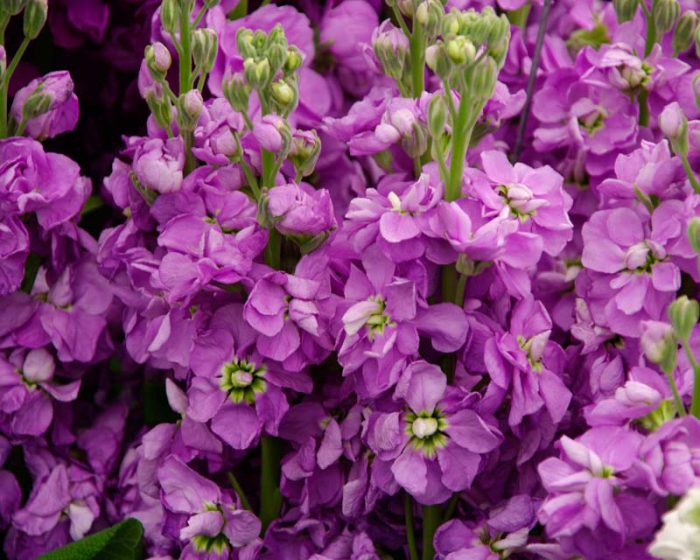
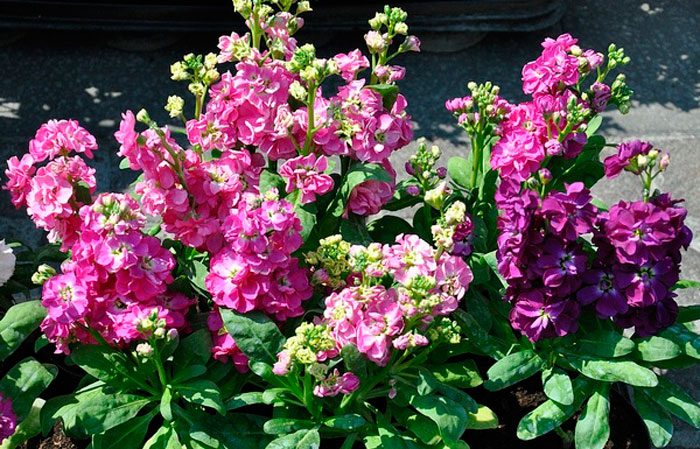
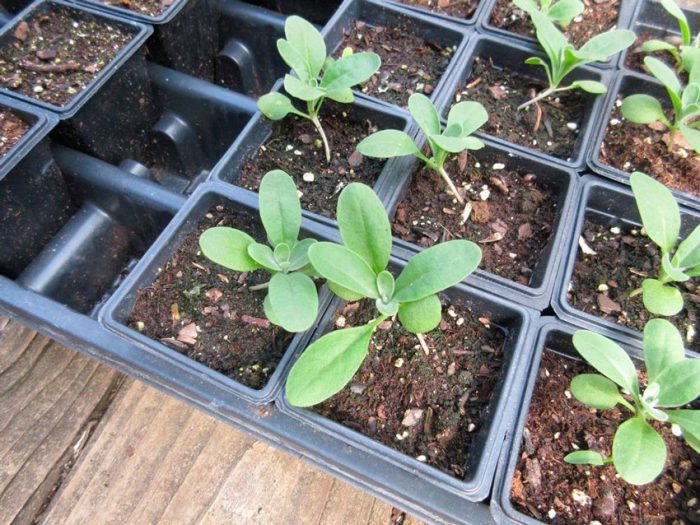
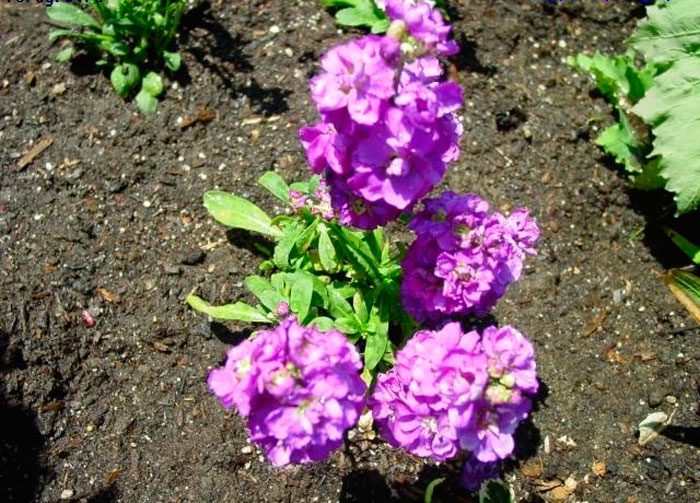
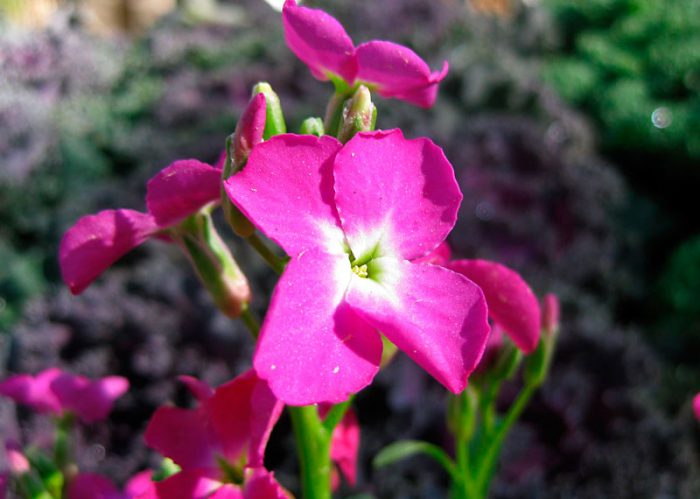

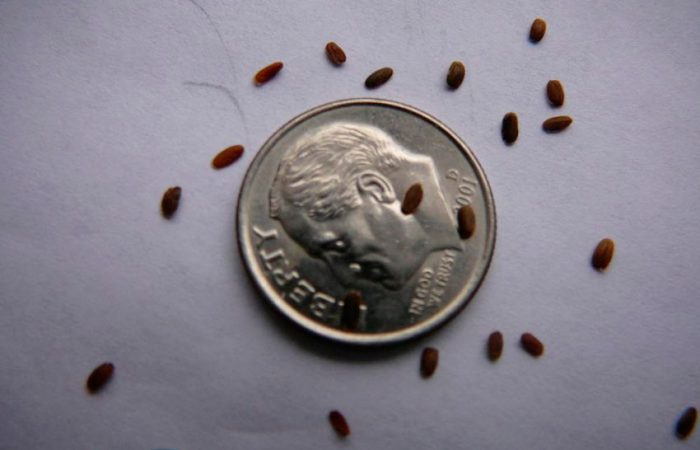
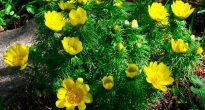









Levkoy seeds cannot be soaked, because of this they are covered with a layer of mucus. Sowing such seeds becomes difficult.